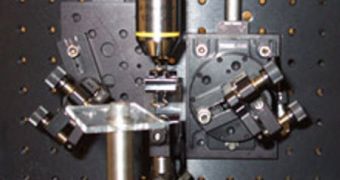Experts at the Harvard University have recently developed a new class of tiny optical devices, which is able to handle single cells inside a liquid, using nothing more than the power of photons, the elementary particles that make up light. The new class of optical traps is a part of the same technology created in the 1980s, but the main difference is that the innovation can be used inside microfluidic devices, small labs-on-a-chip that wil be employed in the future to identify a number of diseases or water contaminants inexpensively and within only a few minutes.
According to Technology Review, the new optical traps can perform the same actions on a very small chip and they usually require a full-scale lab, a large microscope, and a very powerful laser. Regularly, this type of instruments costs tens of thousands of dollars and relies on the momentum that the massless photons have in order to control a cell, or single atom, by keeping them absolutely still. The experts can then thoroughly observe the target, and only release it when they've finished their study. But Harvard Associate Professor of Electrical Engineering Kenneth Crozier and his team wanted to translate the technology into a device that could be used to detect diseases and other contaminants.
The expert reveals that the new device he and Harvard researchers Ethan Schonbrun and Kai Wang created can trap particles easily and that it could be used inside microfluidic devices in the near future. One possible application would be to image and catalog all disease cells inside a blood sample. Regularly, microfluidic devices use channel-width variations, and voltage differences to control the cells in a sample, but the new optical trap, once incorporated into a lab-on-a-chip, could gently attract cells to the instrument's surface, analyze them, and then sort them according to type.
The new finds were presented at the annual conference of the Optical Society of America, which was held this month, in San Jose, California. Crozier adds that the new technology focuses light in very much the same way usual microscopes do. The optical trap is made up of two differently patterned chips. One resembles a silicon chip patterned with a ring with a radius of five micrometers, while the other is inscribed with an array of 64 bullseye patterns. “Each has the function of a confocal microscope and could be used to get a 3-D picture of a cell,” the expert reveals.

 14 DAY TRIAL //
14 DAY TRIAL //